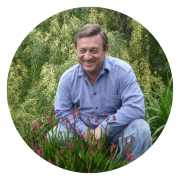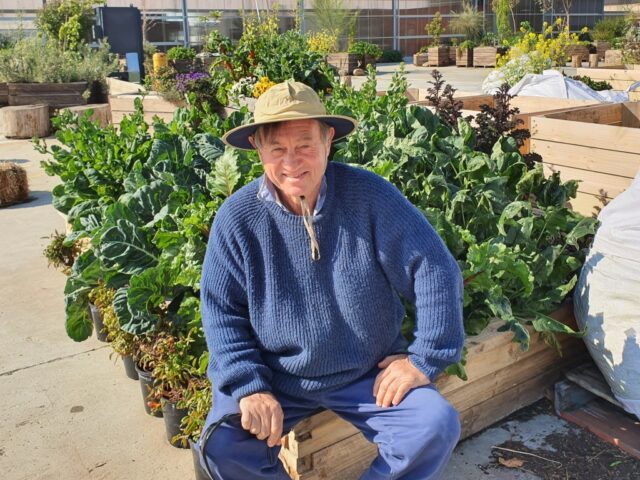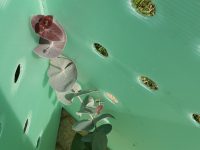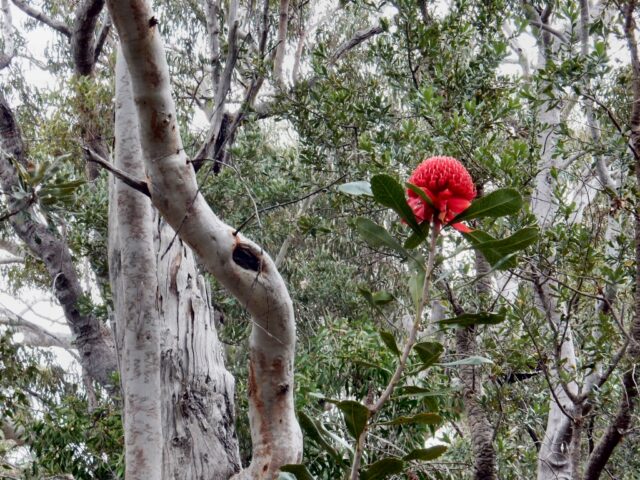Spring is in full swing, it is such an inspiring time to get out in the garden and also out and about in nature, though not so great for all the drought affected people at the moment – hoping there will be good steady rains for them soon.
Bush walking and gardening are some of my favourite things to do and are so good for both the body and the mind. Out on walks and in the garden we see natural things abounding, and it is one of life’s very simple and wonderful pleasures to appreciate them and feel a desire to nurture, protect and conserve them. Sometimes this can feel like an overwhelming task. We are living in an era where environmental issues can no longer be put on the back burner. So many people are beginning to feel the need and urgency that something must be done. We hear about pressing environmental issues every day on the news and radio and many of us feel the weight of the inaction from our politicians of both major parties. Thus we see movements of people risking their own safety to fight for change and we see amazing individuals such as Greta Thunberg and David Attenborough rising up and challenging those in authority to take action. I applaud those who have the fighting spirit and courage to speak up and give our Earth a voice, and also be the voice for science and good sense. It is also important to recognise that there are also those who are taking action in their own very quiet ways at an individual level to honour the commitment of the Thunbergs and Attenboroughs. In particular, I personally feel a great responsibility to side with David Attenborough to show that us older citizens want to use whatever experience and wisdom we have gained to help younger generations replace those politicians who are clearly working against a sustainable future.
Taking action in our own quiet ways….what does this mean?
There are many ways we can take action on an individual level, in our own back yards and with our own life style that can make a huge difference. I’m here to say that one person can make a difference! Taking individual action doesn’t have to be hard work, in fact it is often incredibly satisfying and enjoyable. Sometimes it’s the little changes that can have quite a snowballing positive affect into the rest of our lives. My major health issue in contracting type 2 diabetes recently showed me just how much one change can lead to wanting to make more, and once you see a good outcome, you want to go even further! I always thought I was very active, but once I made it part of my routine to take at least half an hour out to walk or work in the garden every day, I realized how I had fallen short of being active enough. A major change in my diet to drastically reduce my intake of carbohydrates such as sugar and starchy processed foods has gone hand in hand with eating much greater quantities of green vegetables high in fibre. The combination of lower carbohydrates and more regular daily exercise has resulted in losing close to 15 kg and reversing the type 2 diabetes, however, it will remain a life long challenge to make this a permanent lifestyle change. I found that once I started taking more and more interest in the detail of the vegies and fruit I was eating, it made me want to get out into the garden more and grow even more goodies to use in my cooking. All of this is also reducing my carbon footprint through cutting out as much processed (and largely unhealthy) food from my diet. And of course eating fresh generates heaps of organic kitchen scraps to feed my worm farms to in turn feed the garden.
So, just as one person’s discarded plastic item can grow into a Pacific floating plastic nightmare, action in the other direction can equally grow into a wonderful dream. I have been seeing councils installing drains to capture rubbish before it gets into waterways, and they are saying just what a difference it makes. Banks of plantings of tough plants like Lomandras, tall kangaroo paws and Dianellas in the right place can slow storm water and filter nutrients from runoff, and also provide habitat for small creatures. And did you know that grassy perennials like these also sequester carbon, not just the trees! Our own back yards, purposefully planted, can become habitat for wildlife and also help restore some of what has been lost through construction and development. Trees planted in urban areas to cool summer heat and give our birds a home and food (if the right native varieties are planted), but do your homework to make sure you don’t create a problem with overly large ones or with roots infiltrating where they shouldn’t. When in doubt, consult your local nursery…..good ones have passionate and knowledgeable staff who really know their plants.For my part I have a 15 hectare backyard on my farm where I am progressively planting an arboretum of Australian plants in conjunction with my local landcare group. I will be showing you the progress of the project in my newsletters and in particular the results of my deep planting trials to see what difference this can make to the water requirements and growth rate of woody plants – the picture below is of a deep planted Blue Gum from last month’s spring planting….good new growth happening!
The results I have seen with this technique in various Australian environments over the last 20 years suggest to me that it is an absolute game changer in establishing trees with minimal inputs of water and subsequent follow up maintenance. This would certainly be a great tool for those of us who really want to make a difference in environmental restoration.
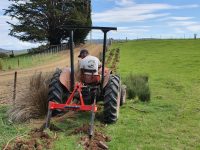 Ripping the soil on my farm in readiness for planting blue gums
Ripping the soil on my farm in readiness for planting blue gums
Expanding beyond our own back yards
Starting in our own back yards is a fantastic way to make a difference and it may create a desire to want to do more! If you are feeling the itch to branch out beyond your home dwellings, there are many ways you can do so. There are lots volunteer based groups dedicated to caring for the environment who can often go unnoticed, but the work they are doing is invaluable. Groups of people such as Landcare (of which I am a member on the Tasman Peninsula), Clean4Shore, Litter Heroes and Bushcare just to name a few, do wonderful things to help reduce human impact and restore some of what has been lost. I grew up on the Central Coast NSW and still visit that area. Previous councils had the foresight to leave great areas of bushland, but some had become bereft of plants I had grown up enjoying. But gratifyingly, lately friends and family have watched how various Bushcare groups have transformed some very special places around the area. Bushland filled with lantana, bitou bush, privet and other exotic invasive plants have patiently been weeded with the aim of restoration of the previous natural growth, and it’s amazing to see the difference they have made from their efforts. It has been wonderful watching beautiful Australian natives such as flannel flowers and waratahs that I remember from my childhood germinate and flourish in the carefully cleared spaces. You can see fish return to creeks, eels pass by, kookaburras, black cockatoos, wrens and much more.
Small groups of volunteers often only do things on a monthly basis, but these small efforts all add up to a bigger whole.People from all different walks of life join these groups and become united by one cause: To make a contribution to bettering the environment. Joining a group such as this may seem like a selfless act, but in fact the personal benefits of doing so are also very rewarding for both your physical and mental health. Stepping up and admitting that we are accountable for the state that the Earth is in (both the good and the bad can be included here) is taking action. Some people may want to sit on their hands and blame the generations of the past. “I didn’t do this, I was born into a world where we burn coal for electricity, buy our fruit and vegetables from the supermarket, run petrol powered cars.” But are these constructive thoughts? Are these thoughts going to help shape the future towards a more positive one? A future where people, plants and animals can all share and respect this Earth? A world where plants and animals don’t have to face extinction for the sake of an ever increasing human population, some of whom are consumed by unnecessary greed.It is most certainly dedicating precious time for the greater good, however, so much more can be gained! Many people I know who have joined groups such as these find they do it for the greater good to begin with, but end up getting so much out of it. The groups can be a wonderful way to gain social interactions and connect with like-minded people. You will most likely also end up making life-long like-minded friends by joining one of these groups. The greatest antidote to the negativity of certain environmentally challenged world leaders is to get out there and act at an individual level each and every day.
National Bird Count – Citizen Science at work
As I’m writing this, the National Bird Count is underway. The National Bird Count helps BirdLife Australia understand more about the birds that live where people live. They would like anyone who can to spend 20 mins in their back yard (which may be an apartment, a park, a beach or the main street of town) and count any birds they see within this time frame. I think this is a fantastic way to help, so I shared it on social media and then I sat down and did my count. As I was sitting I realised it had been a while since I took time to just sit and observe. It was relaxing and I found myself absorbed in bird watching. Feeling the sun and breeze on my skin, noticing the rustling of leaves and the different sounds of insects and birds being carried through the air. Doing the bird count was enjoyable on the day, but it also helped changed my mindset and focus for longer than the 20 minutes I was bird watching. As I did my morning walk the next day, my brain was still thinking about spotting birds, so instead of thinking of all the tasks ahead in the day like I usually do at this time, I paid attention to what birds I could see and hear. In counting 3 of this and 2 of that, I thought of what tree they lived in and what I could plant to further benefit them. So, a seemingly small action of partaking in a bird count has not only helped deliver useful information to BirdLife Australia for the greater good, but it has also expanded my own personal thinking and awareness. If you want to partake in the National Bird Count, it is on until October 27th 2019 – check out the details here-https://aussiebirdcount.org.au/
And coming up in November will be the Wild Pollinator Count, another time to get out into the garden and observe and record – https://wildpollinatorcount.com/
